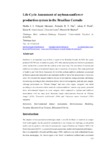Use este identificador para citar ou linkar para este item:
http://www.alice.cnptia.embrapa.br/alice/handle/doc/1035860Registro completo de metadados
| Campo DC | Valor | Idioma |
|---|---|---|
| dc.contributor.author | MATSUURA, M. I. da S. F. | pt_BR |
| dc.contributor.author | DIAS, F. R. T. | pt_BR |
| dc.contributor.author | POCOLI, J. F. | pt_BR |
| dc.contributor.author | LUCAS, K. R. G. | pt_BR |
| dc.contributor.author | CASTRO, C. de | pt_BR |
| dc.contributor.author | HIRAKURI, M. H. | pt_BR |
| dc.date.accessioned | 2016-02-02T11:11:11Z | pt_BR |
| dc.date.available | 2016-02-02T11:11:11Z | pt_BR |
| dc.date.created | 2016-02-02 | pt_BR |
| dc.date.issued | 2015 | pt_BR |
| dc.identifier.citation | In: INTERNATIONAL CONFERENCE ON LIFE CYCLE ASSESSMENT, 6., 2015, Lima, Peru. LCA, Tool for innovation in Latin America: proceedings. Lima, Peru: Pontifical Catholic University of Peru, 2015. p. 224-230. | pt_BR |
| dc.identifier.uri | http://www.alice.cnptia.embrapa.br/alice/handle/doc/1035860 | pt_BR |
| dc.description | Sunflower is an important crop in Parecis region of the Brazilian Cerrado. In 2014, the region produced 232.700 tons of sunflower grains, 45% ofthe national production. Sunflower production comes mostly from a system that has soybean as the main crop. The association of soybean and sunflower can reduce environmental impacts due to shared use of resources. This study performed a cradle to gate Life Cycle Assessment (LCA) of the soybean-sunflower production system used in Parecis region and compared its environmental profile to that of the monoculture of these two crops. We evaluated the impacts related to the use of soil (land use change emissions and liming) for each crop according to three allocation criteria: time of soil occupation, yield and gross margin. Although performance on Climate Change and some other impact categories had varied according to the allocation criteria used, the soybean-sunflower rotation crop system presented lower environmental impacts on every category when compared to soybean and sunflower monocultures with the same yield. Important impact reductionswere observed on Climate change (43%), Terrestrial acidification (26%) and Particulate matter formation (20%) categories. | pt_BR |
| dc.language.iso | eng | eng |
| dc.rights | openAccess | eng |
| dc.subject | Avaliação do ciclo de vida | pt_BR |
| dc.subject | Environmental Modeling | pt_BR |
| dc.subject | Savanna | pt_BR |
| dc.subject | Rotation crop systems | pt_BR |
| dc.subject | Allocation Criteria | pt_BR |
| dc.title | Life cycle assessment of soybean-sunflower production system in the Brazilian Cerrado. | pt_BR |
| dc.type | Artigo em anais e proceedings | pt_BR |
| dc.date.updated | 2016-02-02T11:11:11Z | pt_BR |
| dc.subject.thesagro | Soja | pt_BR |
| dc.subject.thesagro | Girassol | pt_BR |
| dc.subject.thesagro | Cerrado | pt_BR |
| dc.subject.thesagro | Impacto ambiental | pt_BR |
| dc.subject.thesagro | Helianthus Annuus | pt_BR |
| dc.subject.nalthesaurus | Soybeans | pt_BR |
| dc.subject.nalthesaurus | Life cycle assessment | pt_BR |
| dc.subject.nalthesaurus | Environmental assessment | pt_BR |
| dc.description.notes | CILCA 2015. | pt_BR |
| riaa.ainfo.id | 1035860 | pt_BR |
| riaa.ainfo.lastupdate | 2016-02-02 | pt_BR |
| dc.contributor.institution | MARILIA IEDA DA S F MATSUURA, CNPMA; FERNANDO RODRIGUES TEIXEIRA DIAS, CPAP; JULIANA FERREIRA PICOLI, FEA-UNICAMP; KÁSSIO R. GARCIA LUCAS, UEL; CESAR DE CASTRO, CNPSO; MARCELO HIROSHI HIRAKURI, CNPSO. | pt_BR |
| Aparece nas coleções: | Artigo em anais de congresso (CNPMA)  | |
Arquivos associados a este item:
| Arquivo | Descrição | Tamanho | Formato | |
|---|---|---|---|---|
| 2015AA039.pdf | 48.07 kB | Adobe PDF |  Visualizar/Abrir |









